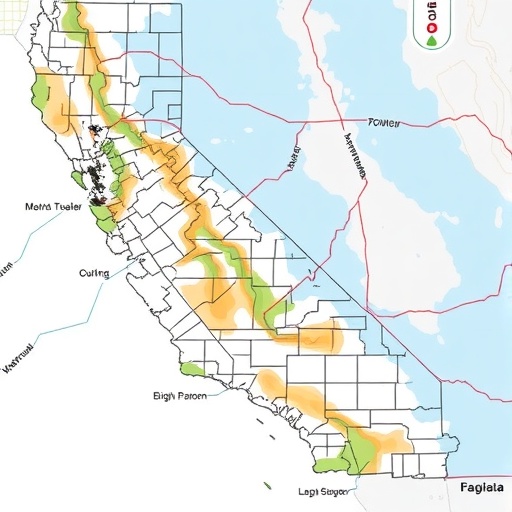California’s water supply has long been at the mercy of climate pendulums, swinging sharply between periods of devastating drought and torrential storms. As global warming accelerates these fluctuations, the state faces unprecedented challenges in managing its water resources effectively. A newly published study from researchers at the University of California, Davis, now uncovers how these climatic extremes directly impact water prices, revealing startling volatility in surface water costs while groundwater prices remain remarkably steady.
The research, appearing in the esteemed journal Nature Sustainability, provides groundbreaking economic insight into California’s water market dynamics from 2010 to 2022—a period punctuated by both historic droughts and record rainfalls. This comprehensive analysis of water transaction data highlights a dramatic divergence in pricing behavior: during times of drought, the cost of surface water—sourced from rivers, lakes, and reservoirs—soars to more than triple its level in wetter years, pushing prices up by an average of $487 per acre-foot. Meanwhile, groundwater transactions exhibit a surprising stability, vindicating its critical role as a buffer amid environmental volatility.
Lead author Madeline Turland, an expert in resource economics, emphasizes the significance of this dichotomy. “Surface water markets respond intensely to precipitation variability, causing extreme price swings that are unpredictable and burdensome, especially for agricultural and urban users. Groundwater, conversely, acts like a financial stabilizer, maintaining consistent pricing despite erratic weather,” she explains. This stability stems from the underground aquifers’ vast storage capacity, which surpasses surface reservoirs by eight to twelve times, yet remains underutilized as a storage mechanism for excess surface water during wet periods.
The study’s findings illuminate the immense potential for integrated water resource management—a coordinated strategy that harnesses both surface water and groundwater in tandem. By blending these supply sources wisely, California could mitigate the price shocks that strain its agricultural economy and urban consumers during times of scarcity. Such coordination would require overcoming significant institutional and legal hurdles rooted in the state’s complex water rights system, where seniority governs allocations on surface water but formal recognition of groundwater rights is sparse and evolving.
In particular, Turland underscores that the legal ambiguity surrounding groundwater complicates joint management efforts. Unlike surface water, designated by a hierarchy of water rights dating back decades or even centuries, groundwater rights are largely unformalized unless adjudicated by court decisions in basins beset by disputes. However, the recently enacted Sustainable Groundwater Management Act (SGMA) introduces a regulatory framework aiming to achieve basin-wide sustainability by 2040, potentially ushering in judicial oversight on groundwater usage that could synchronize with surface water governance.
The economic implications of these regulatory and management paradigms are profound. Researchers argue that increasing water storage capacity via new reservoirs or by enhancing existing infrastructure—through dam height increases or sediment removal—faces daunting fiscal, environmental, and social trade-offs. These options often yield only marginal or temporary storage gains, leaving the state vulnerable to price instability. Instead, leveraging the natural resilience and scalability of groundwater storage emerges as a cost-effective alternative that could dampen the shocks to water pricing induced by erratic precipitation patterns.
The data-driven methodology employed in this study meticulously aggregated transaction records over a dozen years, capturing fluctuations across multiple wet and dry cycles. This robust dataset allowed the researchers to isolate pricing trends with a high degree of confidence, revealing how market participants value water differently depending on scarcity and availability. Groundwater’s role as a dependable fallback source became evident, dispelling myths that it would be equally price-volatile under extreme climate conditions.
Importantly, the study highlights the broader economic and societal stakes tied to water pricing volatility. Price surges complicate operational planning across agriculture—where water is a fundamental input—while elevated water costs ripple through urban economies, impacting everything from household budgets to industrial productivity. The findings call for policymakers and water managers to rethink conventional water system designs and embrace innovative frameworks that harness the storage and price-stabilizing benefits of groundwater.
Moreover, this research reveals the intricate interplay between hydrological realities and legal frameworks. The seniority-based surface water rights system reflects historical allocation priorities but may no longer be optimal under changing climate variability. Coupling this with a more structured and legally enforceable groundwater regime could foster a more resilient water market, smoothing out sharp price escalations and ensuring equitable distribution amidst scarcity.
While the study’s conclusions primarily focus on California, they resonate with water management challenges globally, where climate change imposes similar stresses on hydrological systems prone to drought and flooding. Its insights offer a conceptual roadmap for regions grappling with the dual imperatives of economic efficiency and climate resilience in water resource governance.
In closing, UC Davis researcher Madeline Turland emphasizes the urgency of reforming water management strategies in light of climate realities. “Our analysis demonstrates that coordinated management of surface water and groundwater is not just a technical necessity but an economic imperative. It can safeguard communities, underpin agricultural viability, and help California—and potentially other drought-prone regions—navigate an uncertain water future with greater stability and equity.”
This study was made possible by the support of the United States Department of Agriculture National Institute of Food and Agriculture and the Giannini Foundation of Agricultural Economics, with contributions from Columbia A. Carter, Bulat Gafarov, Jens Hilscher, and Katrina Jessoe of UC Davis. Their collective findings signal a pivotal juncture in water economics, where integrating natural storage capacities with legal innovations may hold the key to weathering an increasingly volatile climate.
Subject of Research: Not applicable
Article Title: Price sensitivity to precipitation and water storage in California
News Publication Date: 21-Oct-2025
Web References: http://dx.doi.org/10.1038/s41893-025-01659-w
References: University of California, Davis study published in Nature Sustainability
Keywords: California water prices, drought, surface water volatility, groundwater stability, Sustainable Groundwater Management Act, water rights, climate change, water storage, economic analysis, water resource management, precipitation impacts, water market economics




